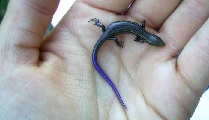Northern Prairie Skink (Plestiodon septentrionalis septentrionalis)
Description: The northern prairie skink (Plestiodon septentrionalis septentrionalis) has more dark striping along the body and tail than the slightly smaller southern prairie skink (Plestiodon septentrionalis obtusirostris), whose stripes are fewer and fainter. Another way to tell them apart is their location. Total length: 5 to 7 1/2 inches (average).
Habitat: The preferred habitat is flat rocks or similar shelter near small prairie streams in tallgrass prairie. This species spends much time under rocks and thatch. It suns for short periods during morning or early afternoon. These lizards require native prairie habitat in order to survive.
Range: Wisconsin, Minnesota, SE North Dakota, E South Dakota, E Nebraska, C/E Kansas, Oklahoma, E Texas, Iowa. Canada (S Manitoba)
Diet: They feed on small invertebrates, preferring spiders, crickets, and grasshoppers, but avoiding ants.
Reproduction: Clutch size is about 4 to 18; averages 7 to 9 in Minnesota, 8 in Kansas, 11 in Nebraska, 9 in Texas; larger females produce larger clutches. Eggs hatch in 1-2 months (by mid-July in Iowa). Sexually mature in 2 years. Female attends eggs until shortly after hatching. Courtship and egg-laying occur in May and June, with the female laying 5–18 eggs in a shallow burrow under rocks or thatch. She remains with her eggs until they hatch. As with many other skinks, the hatchlings have a bright blue tail.
Status: Listed as Least Concern in view of its wide distribution, tolerance of a degree of habitat modification, presumed large population, and because it is unlikely to be declining fast enough to qualify for listing in a more threatened category.
»» Kingdom: Animalia - Animals
»» Phylum: Chordata - Chordates
»» Subphylum: Vertebrata - Vertebrates
»» Class: Reptilia - Reptiles
»» Order: Squamata - Lizards
»» Family: Scincidae - Skinks
»» Genus: Plestiodon
»» Species: Plestiodon septentrionalis - Prairie Skink
»» Subspecies: Plestiodon septentrionalis septentrionalis - Northern Prairie Skink
This article uses material from the Wikipedia article "Prairie Skink", which is released under the Creative Commons Attribution-Share-Alike License 3.0. Content may have been omitted from the original, but no content has been changed or extended.
|











